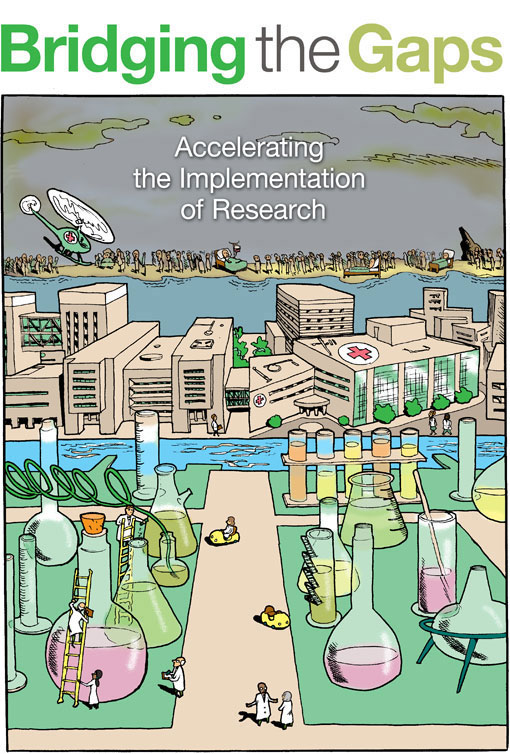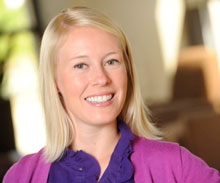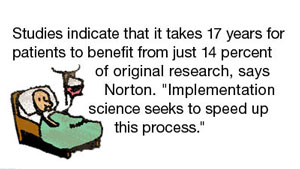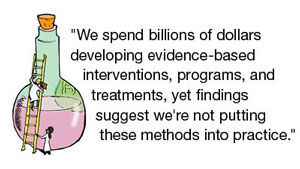
By Jo Lynn Orr | Illustration by Tim Rocks
What is the end result of research? How do the therapies and interventions that scientists develop actually reach the public? Why do new treatments quickly reach academic medical centers like UAB but move on to community hospitals and health clinics much more slowly, if at all? Is a cheaper but less-effective therapy better than one that is more effective but too expensive to be adopted in the real world?
Wynne E. Norton, Ph.D., specializes in asking—and answering—just these kinds of questions. As an expert in the relatively new field of implementation science (IS), she looks for ways to apply research results and other evidence-based findings to real-world practice in health-care and public health settings.
 Wynne Norton specializes
Wynne Norton specializes
in applying research results
and other evidence-based findings
to real-world practice. The Science of Solutions
Studies indicate that it takes 17 years for patients to benefit from just 14 percent of original research, says Norton, an assistant professor in UAB’s Department of Health Behavior in the School of Public Health. “IS seeks to speed up this process, and many agencies within the National Institutes of Health are on board with this goal,” she says. “The Agency for Healthcare Research and Quality also is interested in the health-care delivery aspect, as well as in scale-up and spread, which is an extension of IS that involves facilitating widespread adoption of reliable strategies for effecting evidence-based services.”
Implementation science puts the issue of accountability front and center, says Norton. “We spend billions of dollars developing evidence-based interventions, programs, and treatments, yet findings suggest we’re not putting these methods into practice.” A report in the New England Journal of Medicine (NEJM) in 2003 found that Americans receive the “recommended processes involved in care” only about 50 percent of the time.
Norton lists dozens of potential roadblocks on the path from research to practice, starting with the sheer volume of findings that are produced each year. In a 2001 editorial in the NEJM, UAB associate professor of medicine Terrence Shaneyfelt, M.D., M.P.H., estimated that a physician who wanted to stay current on the latest knowledge would need to read nearly 20 articles a day, every day. Many findings remain hidden from the larger world in scientific journals, Norton adds, and even if they become fully packaged interventions they are often complex and hard to administer, despite investments in awareness campaigns or training manuals.
 Speeding Implementation
Speeding Implementation
Then there are the messy, human factors, including attitudes to change and the ever-present specter of politics. Many Americans assume that the “big ‘P’” policymakers in Washington, D.C., are responsible for the nation’s health-care, Norton says, but the “little ‘p’” policymakers in state and local government actually play a major role in accelerating or impeding the progress of innovations from research findings to real-world implementation, she says.
Norton and colleagues recently polled health department AIDS directors at the city, state, and territory levels about their intention to adopt new evidence-based HIV interventions, for example. They found that just over one-third intended to do so. But there are ways to overcome these barriers to adoption, Norton says, including identifying key opinion leaders and developing workshops to educate and influence those leaders.
Investigating Interventions
Norton’s research at UAB focuses on developing and testing strategies to move evidence-based practices and programs from research settings into everyday practice more quickly, effectively, and broadly. She is particularly interested in how to disseminate and implement effective HIV prevention, treatment, and engagement-in-care interventions in the United States and abroad. Her work focuses on accelerating the research-to-practice transition along the implementation continuum—from adoption of interventions to the effective implementation of interventions in organizations to post-funding sustainability and, finally, national-level scale-up of programs.

In collaboration with researchers from Kaiser Permanente in Colorado, Norton also is seeking better ways to estimate the time and resources needed to transfer research-proven innovations into routine clinical care and public health settings. The researchers have received a grant from the Bill and Melinda Gates Foundation for the project, which aims to develop a set of tools to produce standardized estimates of the diffusion potential of health innovations, interventions, and programs, as well as the capacity and readiness of organizations to adopt, implement, and scale up these solutions.
Spreading the Message
The field of implementation science is still relatively young, Norton says. It is also highly interdisciplinary, involving expertise in everything from organizational behavior and health economics to statistics and social psychology. That makes it intellectually thrilling, Norton continues, but because research is being published in widely disparate areas, it can be difficult to keep up with new discoveries.
In 2007, she and a group of colleagues started a central hub for the latest IS research, which now has more than 500 members worldwide and in 2011 acquired funding from the U.S. Department of Veterans Affairs and the National Cancer Institute. Each month, Norton sends out an e-mail roundup that includes abstracts from more than 100 new journal articles as well as funding announcements, job opportunities, and web-based seminars on implementation science.
There is also currently no standard curriculum for training the next generation of implementation scientists. In September 2010, Norton traveled to Switzerland as part of a joint World Health Organization/USAID initiative to develop learning modules targeted to health officials, researchers and health workers in low- and middle-income countries. Now she is preparing to share her insights with UAB students in a new master’s-level course offering, “Dissemination and Implementation in Health,” scheduled to begin in fall 2012.
“This is a great field, and a wonderful time to enter it,” Norton says. “There is a lot of room for new discoveries.”